Michelin’s New Enduro and DH Tires
Diameters Offered: 27.5’’ and 2.9’’
Stated Widths:
- Wild Enduro MS: 2.4’’
- Wild Enduro MH: 2.5’’
- Wild Enduro Rear: 2.4’’
- DH 16: 2.4’’
- DH 22: 2.4’’
Blister’s Measured Widths (on 30 mm internal-width rim):
- Wild Enduro MS: 2.40’’ (casing) / 2.54’’ (tread)
- Wild Enduro MH: 2.51’’ (casing) / 2.60’’ (tread)
- Wild Enduro Rear: 2.34’’ (casing) / 2.37’’ (tread)
- DH 16: 2.43‘’ (casing) / 2.48’’ (tread)
- DH 22: 2.43’’ (casing) / 2.55’’ (tread)
Blister’s Measured Weights (29’’ diameter):
- Wild Enduro MS: 1,246 and 1,250 g
- Wild Enduro MH: 1,314 and 1,326 g
- Wild Enduro Rear: 1,244 g
- DH 16: 1,363 and 1,368 g
- DH 22: 1,315 and 1,335 g
MSRP: $100
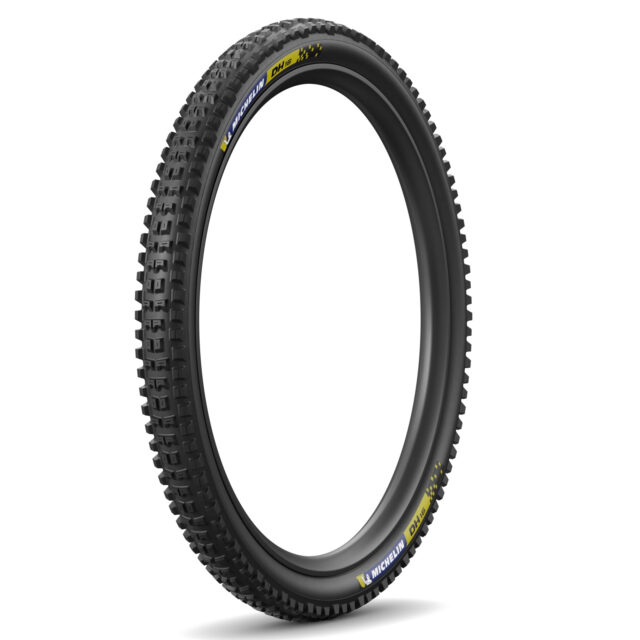
Intro
Michelin has been making bike tires since the late 1800s, and their Comp 16 and Comp 32 were some of the most popular DH tires in the early 2000s. Michelin’s share of the mountain bike market has fallen off somewhat in recent years, but they’ve overhauled their Enduro and DH tire offerings in an effort to change that, and the results look quite promising.
Michelin Wild Enduro Tire Lineup
The new Wild Enduro lineup is comprised of three tires: the Wild Enduro MH, Wild Enduro MS, and Wild Enduro Rear. All three are available in a single casing and rubber compound combo, in both 27.5’’ and 29’’ diameters.
Michelin’s new Enduro casing uses a two-ply construction with dual 55 TPI layers, folding beads with butyl inserts for pinch-flat protection, and a “bead to bead shield” layer with another reinforcing layer under the tread. All three tires share the same general construction (but in different sizes; more on that in a minute) and share Michelin’s reformulated Magi-X rubber compound as well.
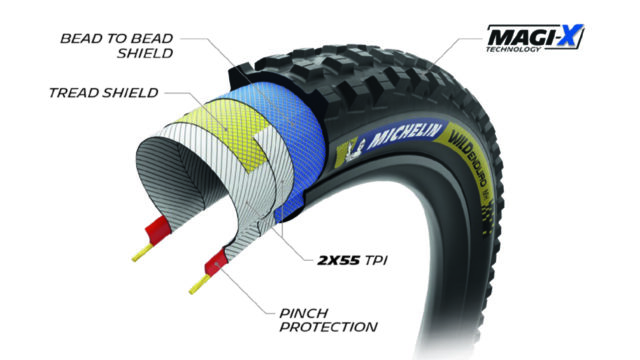
Michelin says the new rubber formulation offers better grip than the earlier iterations, especially in lower temperatures, while being a touch faster rolling and harder wearing.
Michelin has also added the option for a more subtle gray hot patch; their classic blue and yellow one is still available, too.
Wild Enduro MH
First up in the Wild Enduro lineup is the MH (i.e., Mixed Hard) meant for, well, variable conditions that skew to the drier, firmer end of the spectrum. The Wild Enduro MH is offered in a 2.5’’ width only and it’s a notably big, high-volume casing.
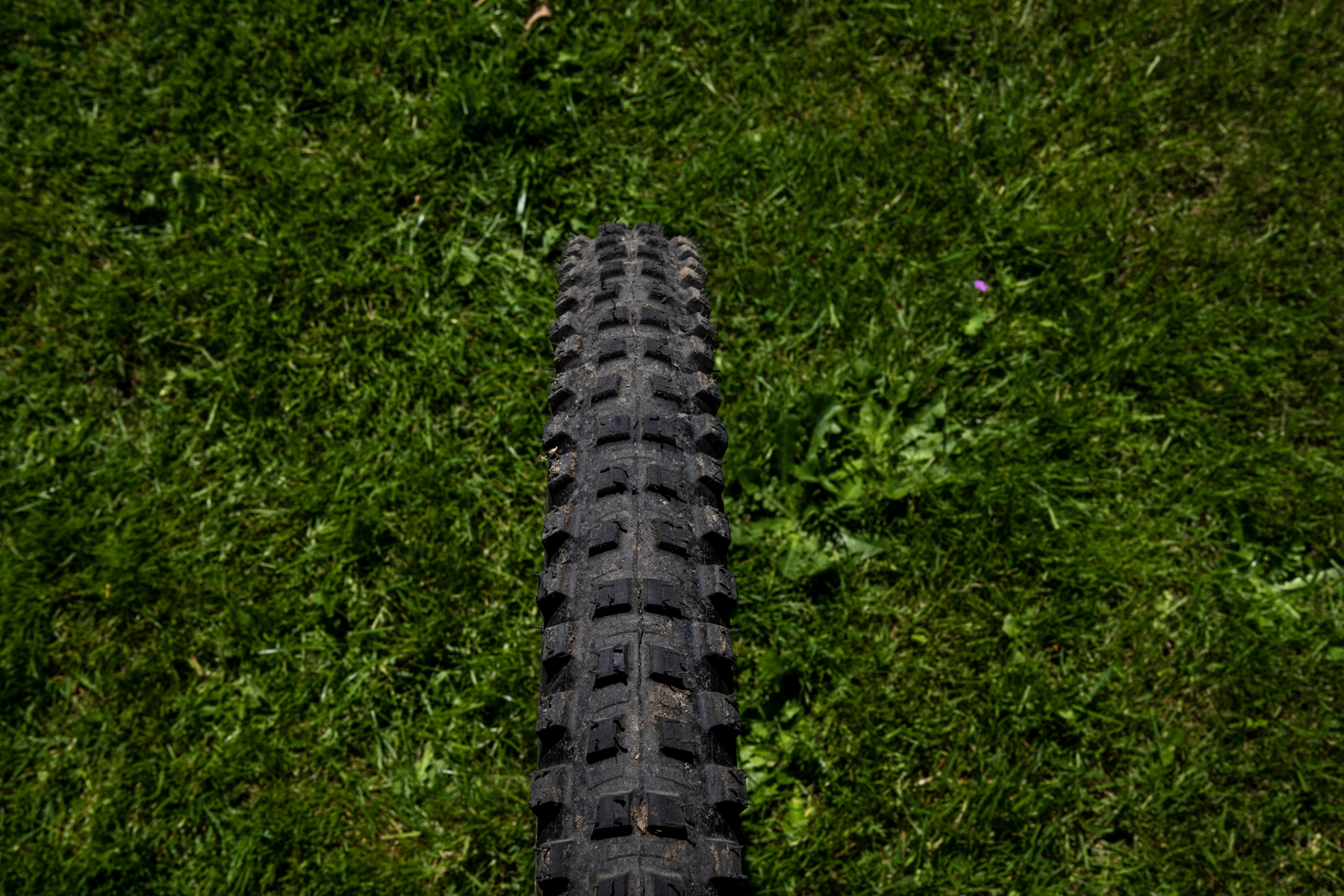
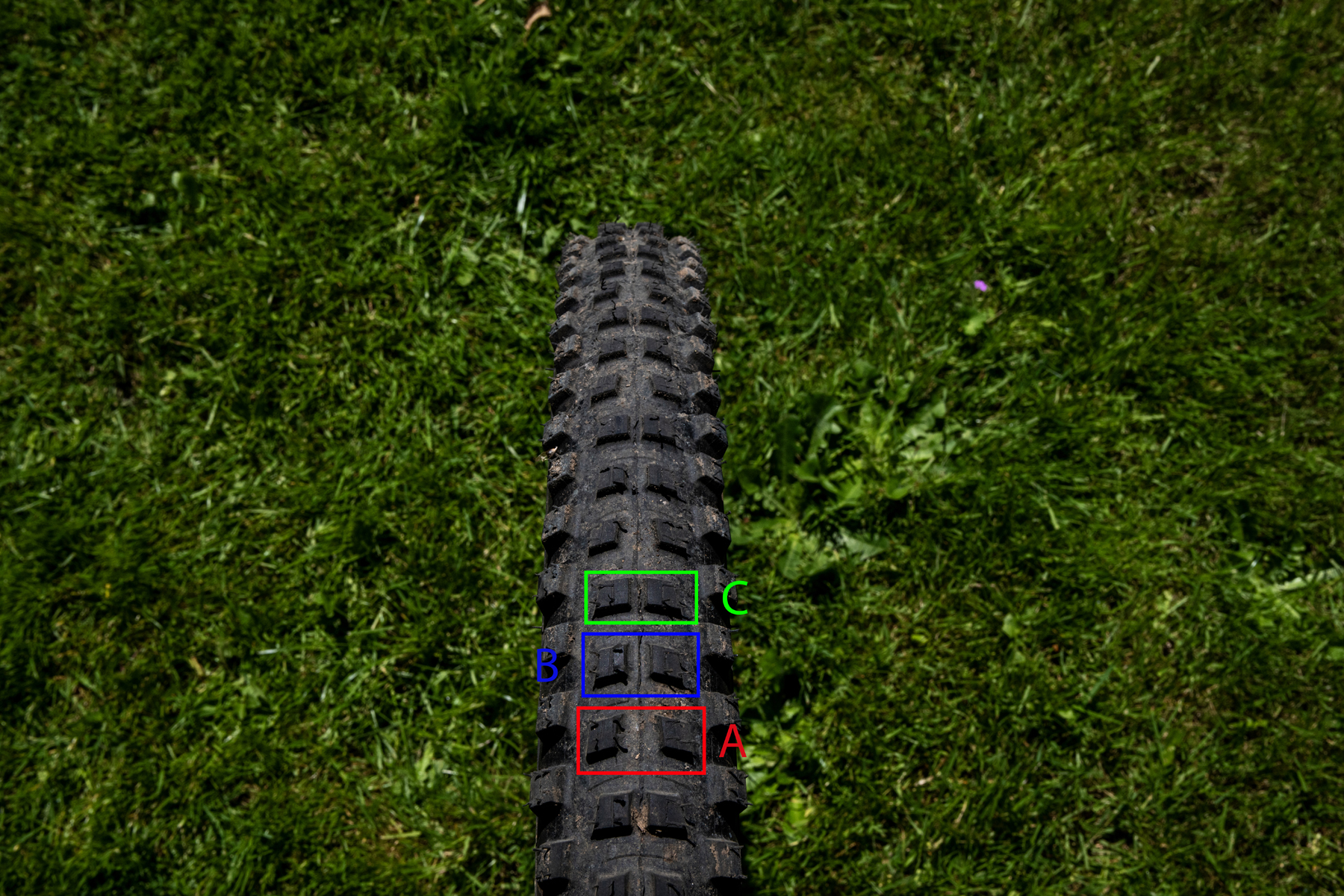
The Wild Enduro MH tread pattern uses two-wide rows of center knobs, with three different sets of spacing between the knobs. The overall shape of the center knobs is consistent across all three rows, but the knobs get slightly narrower as the spacing between them grows wider. All feature a very shallow longitudinal sipe down the middle and a subtle ramp on the leading edge to help reduce rolling resistance. The side knobs are similarly shaped but are taller, and are slightly staggered in their placement to match the spacing of the different rows of center knobs.
Wild Enduro MS
The Wild Enduro MS — “Mixed Soft” — comes in a 2.4’’ width and its casing is not only narrower than that of the Wild Enduo MH, but the MS is appreciably lower volume as well.
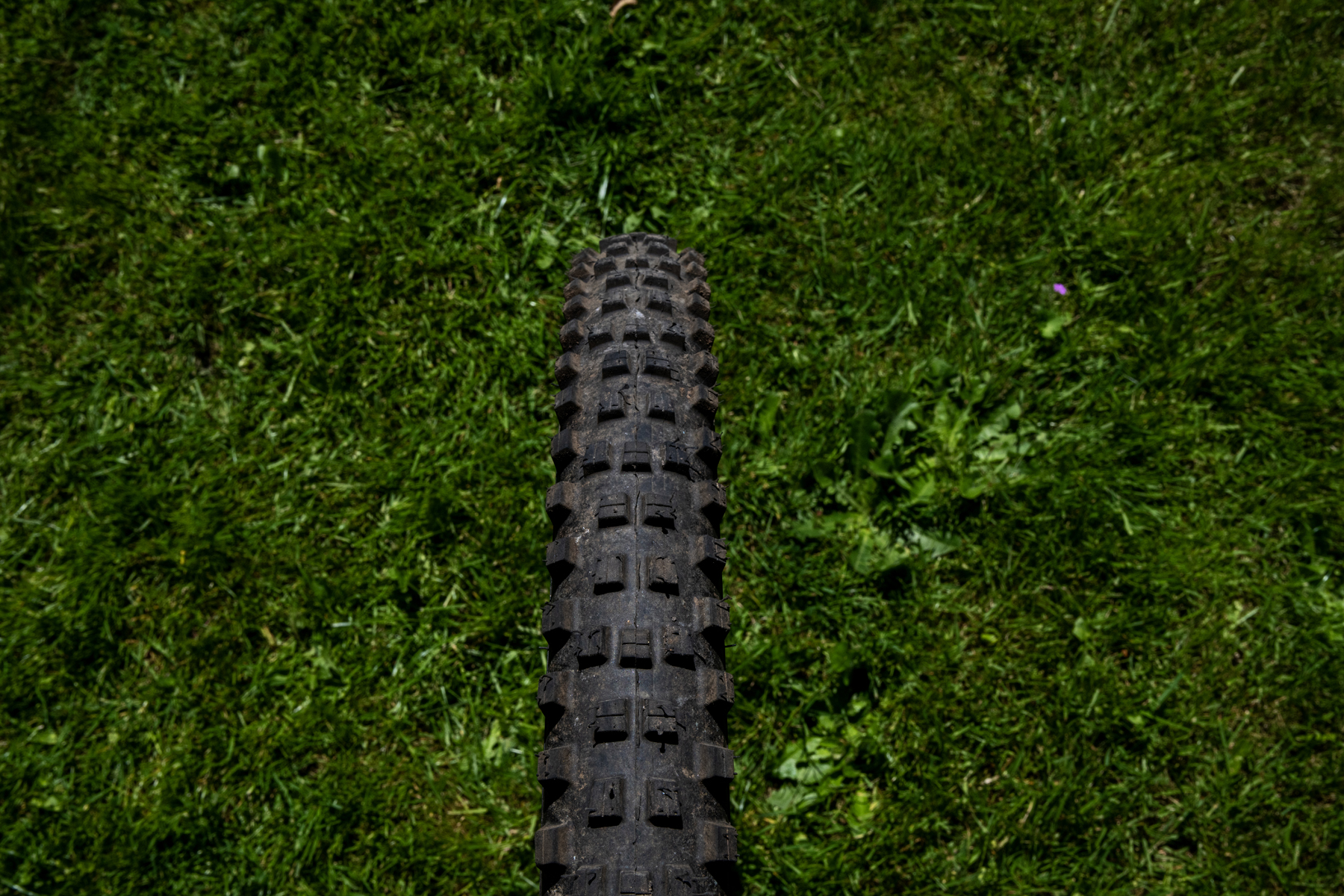
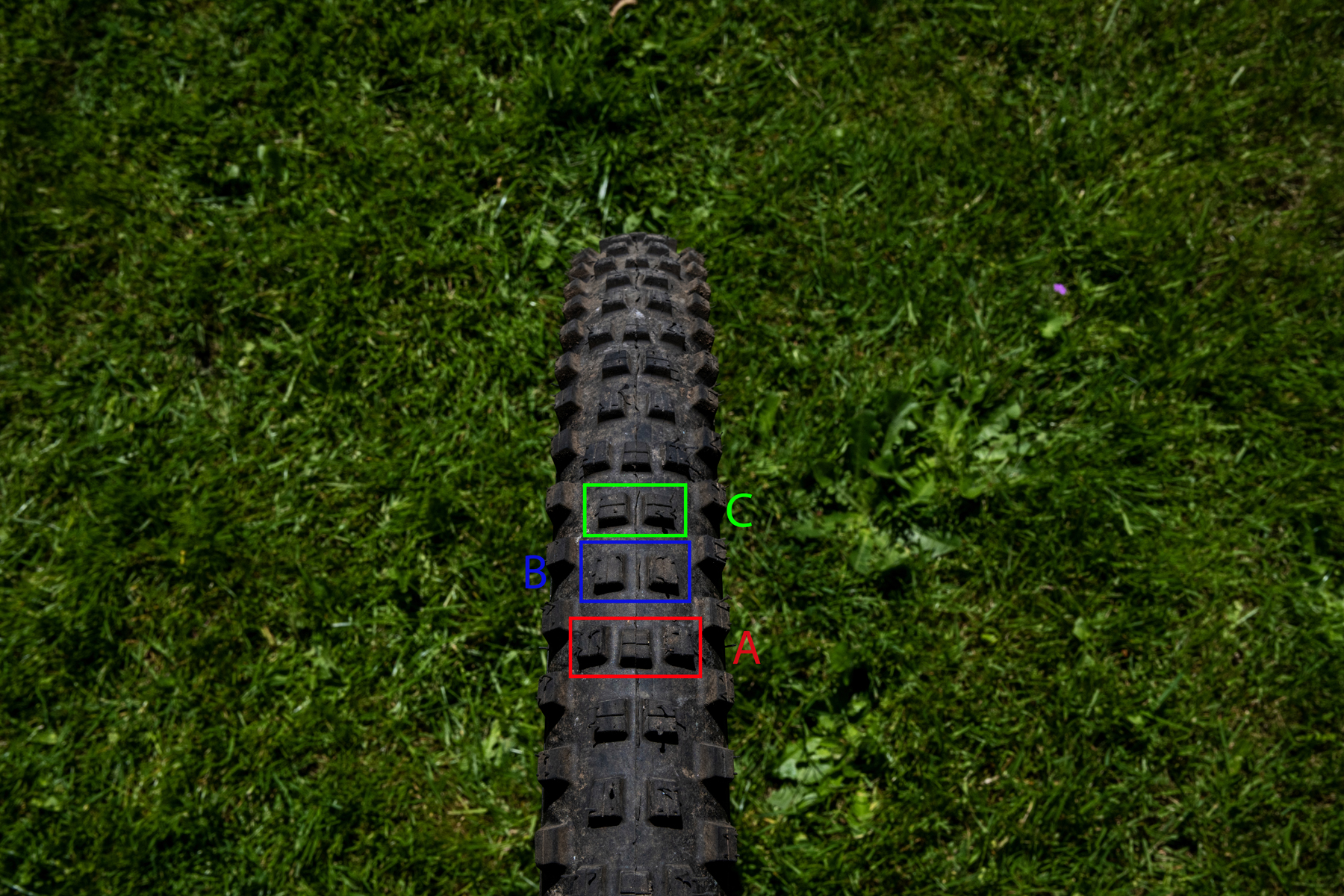
Unsurprisingly, given the Wild Enduro MS’ intended use, its knobs are taller and more widely spaced than those of the Wild Enduro MH. The MS tread also features a 3-2-2 knob arrangement, with the “A” row (which corresponds to the most widely spaced row of center knobs on the MH) getting a third knob in between the other two. Both that center knob and the pair on the most tightly-spaced set of center knobs (row “C”) get a small lateral sipe; the others get a longitudinal one, similar to the MH. The Wild Enduro MS side knobs are slightly more widely spaced and more squared-off / less angled than those of the Wild Enduro MH, but they’re fairly similar in design overall.
Wild Enduro Rear
Finally, the Wild Enduro Rear rounds out the Wild Enduro lineup. It’s not quite a true semi-slick, but features fairly small, low, tightly-spaced center knobs paired with much beefier side ones, meant to minimize rolling resistance while still offering good cornering grip from the side knobs. The Wild Enduro Rear is offered in a 2.4’’ width, only. Its side knobs are slightly lower and much tighter spaced than those on the Wild Enduro MH, but the Rear’s knobs use a similar overall shape and are also staggered in sets of three.
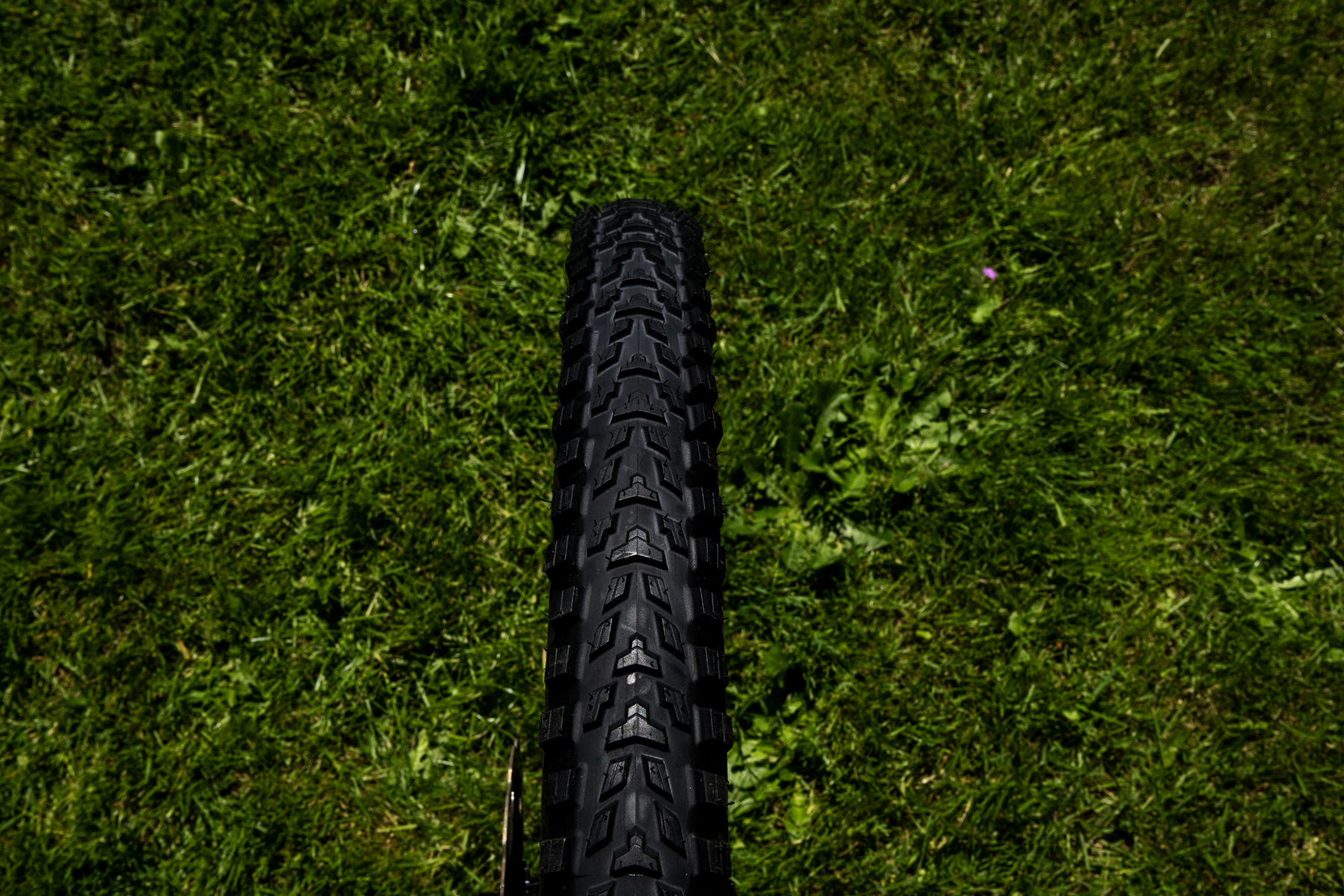
Michelin DH Tire Lineup
Michelin’s DH tires have received the same new Magi-X rubber compound featured in the Wild Enduro tires, along with a new casing construction — including a folding bead, in place of the wire one on the prior iteration of the Michelin DH.
The new DH casing looks very similar to the Wild Enduro one, just with a 120 TPI casing ply replacing one of the two 55 TPI ones in the Enduro tires; Michelin’s stated weights for the DH tires are only about 50 grams heavier than the Enduro ones. That’s a notable change from Michelin’s very heavy prior-generation DH tires, which used wire beads and especially burly (but not very pliable) casings; the prior-gen DH tires also came in several hundred grams heavier than Michelin’s stated weights for the new versions.
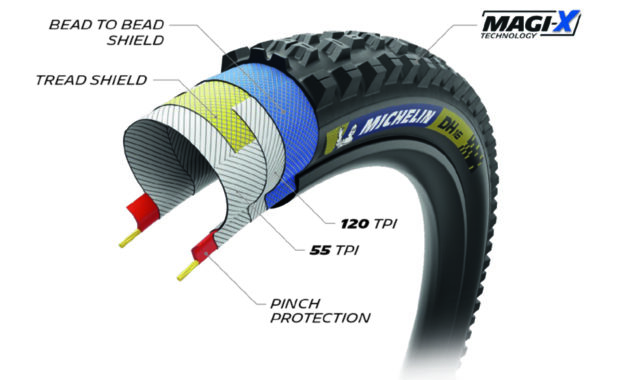
Both of Michelin’s new DH tires are offered in 27.5’’ and 29’’ diameters, a 2.4’’ width, and with either Michelin’s new gray hot patches or the longstanding blue and yellow ones.
DH 16
Michelin describes the DH 16 as a modernized version of the Comp 16 from almost 20 years ago. The DH 16 is meant to be the faster-rolling of their DH tire offerings, for use in mixed conditions.
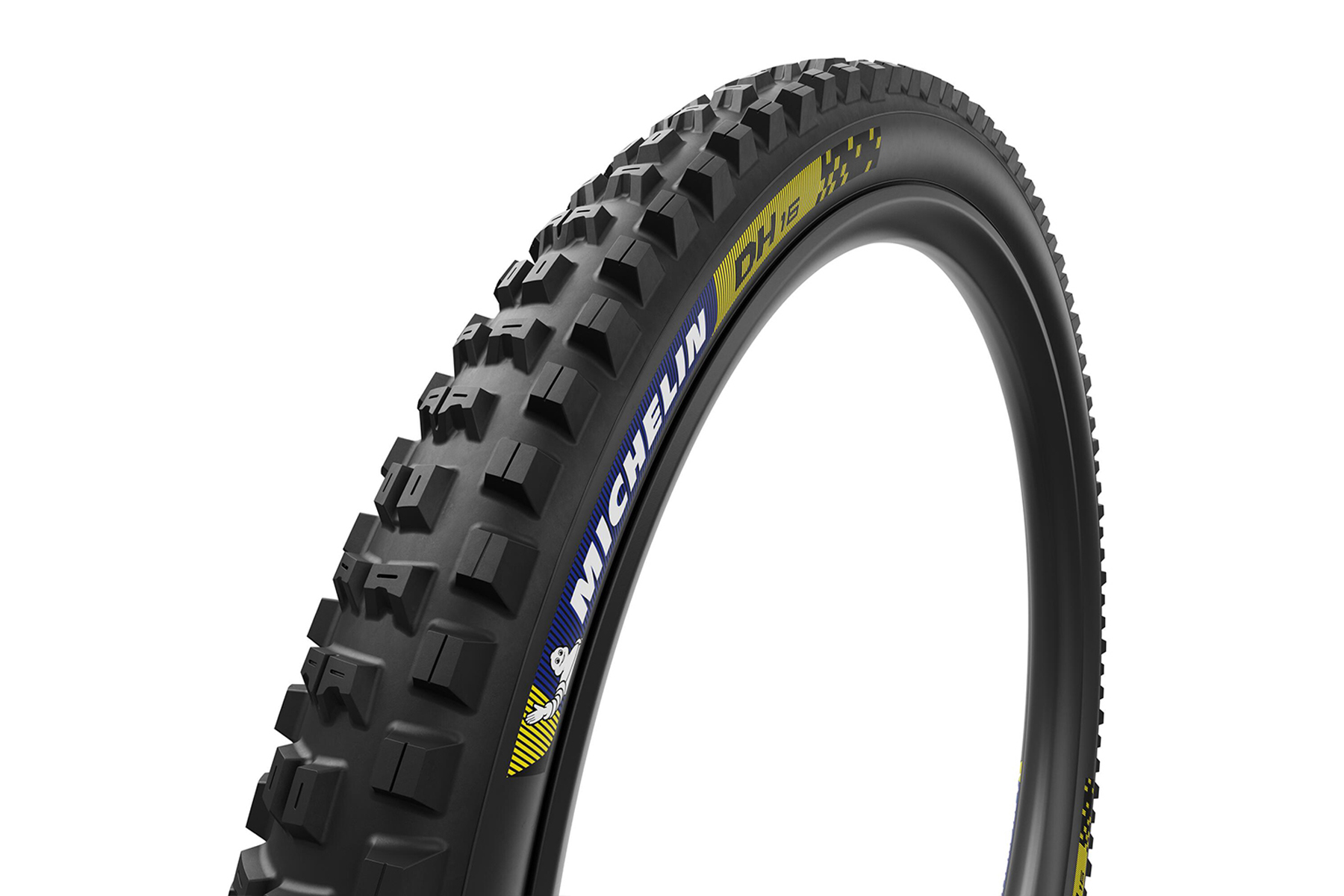
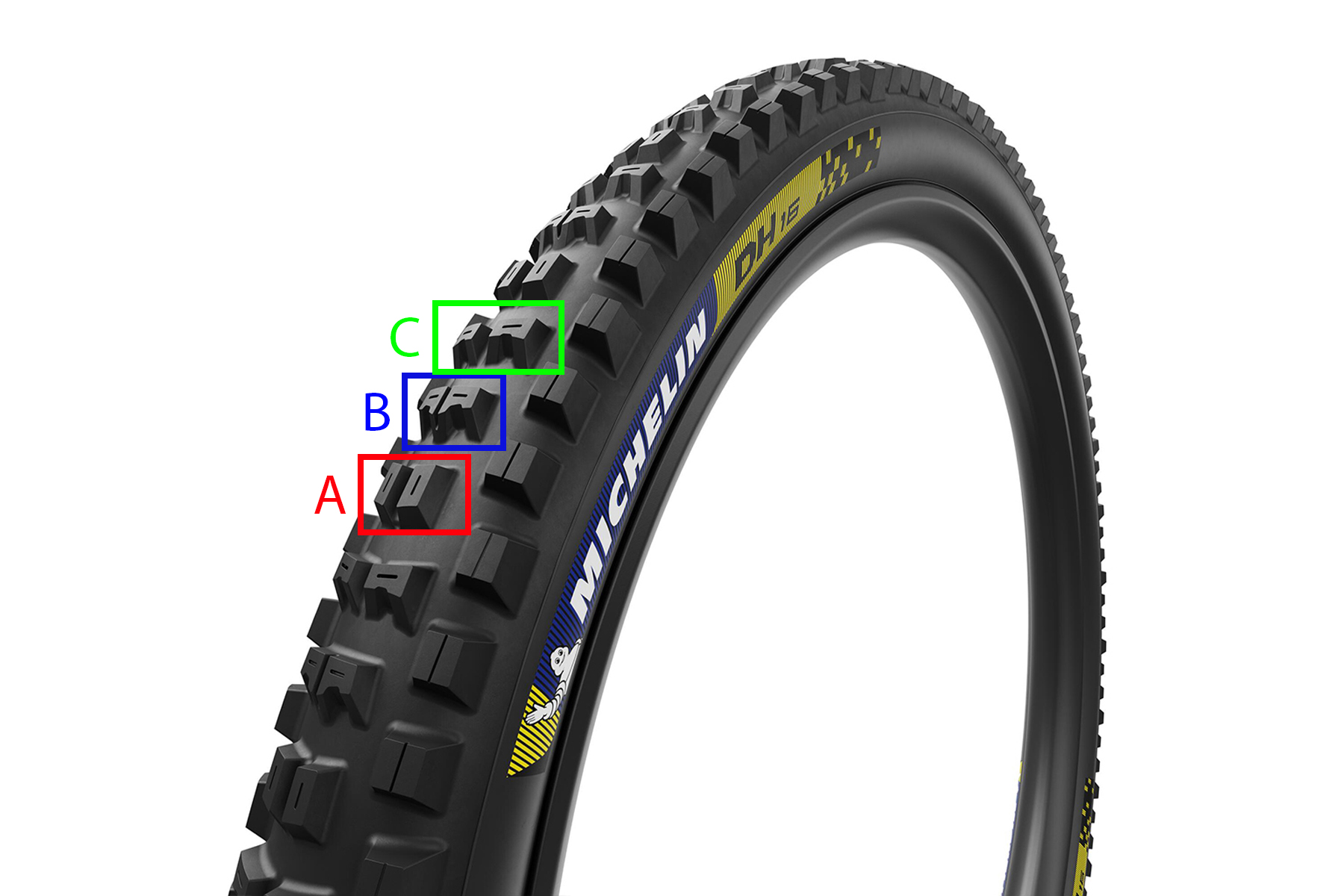
The DH 16 uses three different styles of center knobs, all of which feature substantial ramping on the leading edge, but quite different overall widths. The narrowest knobs (row “A”) are mostly rectangular, with a slightly inward-angled trailing edge to create a cup for braking bite; rows “B” and “C” both feature U-shaped knobs with a cupped leading edge, with row B essentially being a narrower version of row C.
DH 22
The DH 22’s tread pattern looks extremely similar to that of the Wild Enduro MS, just with an extra chamfer on the leading edge of the center knobs, presumably to improve (i.e., reduce) rolling resistance. (It’s also very similar to that of the prior-generation DH22.) The DH 22 is offered in the same 2.4’’ width as well. Like the Wild Enduro MS, the DH 22 is intended for variable conditions at the softer end of the spectrum.
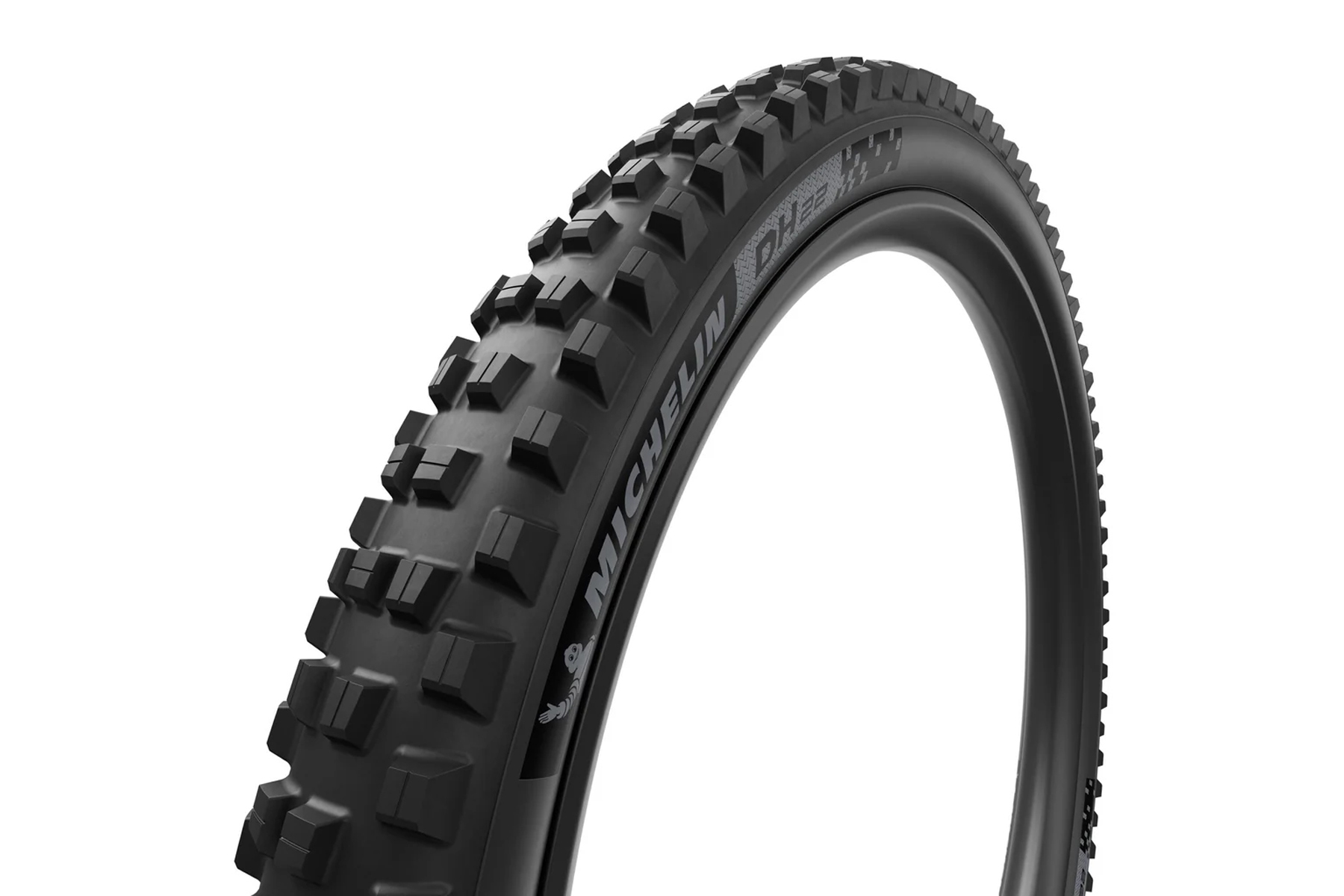
FULL REVIEW
There was a lot that I liked about the prior-generation Michelin DH 22, but even by DH-tire standards, they were notably heavy, and their casing felt quite stiff and wooden. So, when Michelin announced that they’d overhauled the construction to add a folding bead and improve the casing ride quality, I was particularly keen to see what they’d come up with.
My interest was piqued further when I saw that they’d added what appeared to essentially be an Enduro-casing version of the DH 22 (dubbed the Wild Enduro MS), plus a compelling-looking update to the DH 16 and a couple of other Enduro tires to round things out.
We’ve been testing all five of Michelin’s new / updated gravity tires over this summer and fall, and while I haven’t totally clicked with every tire in the lineup, there are a couple of winners here.
Wild Enduro MH
David: The “MH” in the Wild Enduro MH’s name indicates that it’s for mixed / hard conditions, but given that brief, it’s got a relatively open center tread pattern and the way it all comes together is interesting.
Big picture, I think the “mixed” part of the name is a bit more on point than the “hard” part. The Wild Enduro MH decently covers a fairly wide range of conditions, but I wouldn’t characterize it as a hardpack specialist.
In fact, I found the Wild Enduro MH to feel somewhat vague on loose-over-hard conditions, in particular. I like Michelin’s Enduro casing (the overall construction is shared with the Wild Enduro MS and Wild Enduro Rear). Sill, the version used for the Wild Enduro MH is notably higher-volume than that of its siblings, and the Wild Enduro MH feels like it loses some sidewall support as a result — particularly since it’s a tire meant for drier, firmer conditions that put higher demands on the sidewalls.
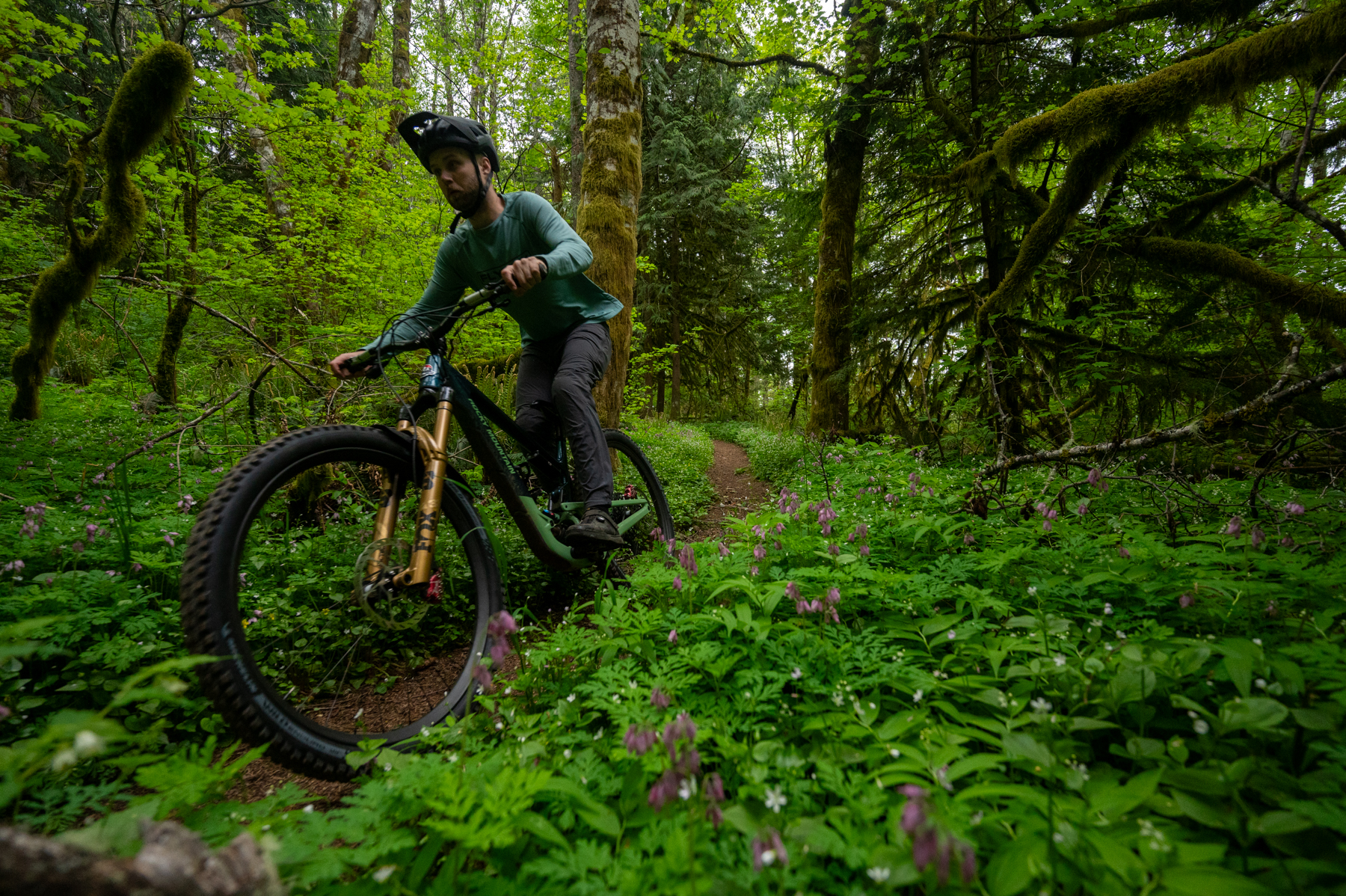
The Wild Enduro MH has fared well durability-wise, but I needed to run higher pressures than I otherwise wanted to in order to keep the sidewalls from folding over when cornering. That felt particularly pronounced on the rear but was true up front to some extent as well.
The Wild Enduro MH’s braking grip is decent, but I also struggled with how abruptly it would cut loose under heavy braking in dry, loose soil. Particularly when switching back and forth between the Wild Enduro MH and the DH 16 (more on that one in a minute), I’ve had a hard time trusting the Wild Enduro MH under really heavy braking. The Wild Enduro MH goes from gripping well to locking up with little forewarning that I was nearing the limit, and tends to step out sideways when it does so.
On the plus side, the Wild Enduro MH rolls surprisingly well, and despite its name, it fares alright in softer, wetter conditions. But, frankly, I wish Michelin had just made an Enduro version of the DH 16 like they did with the Wild Enduro MS and the DH 22. The Wild Enduro MH is a serviceable all-rounder, but in my opinion, it’s definitely the weakest tire in the lineup.
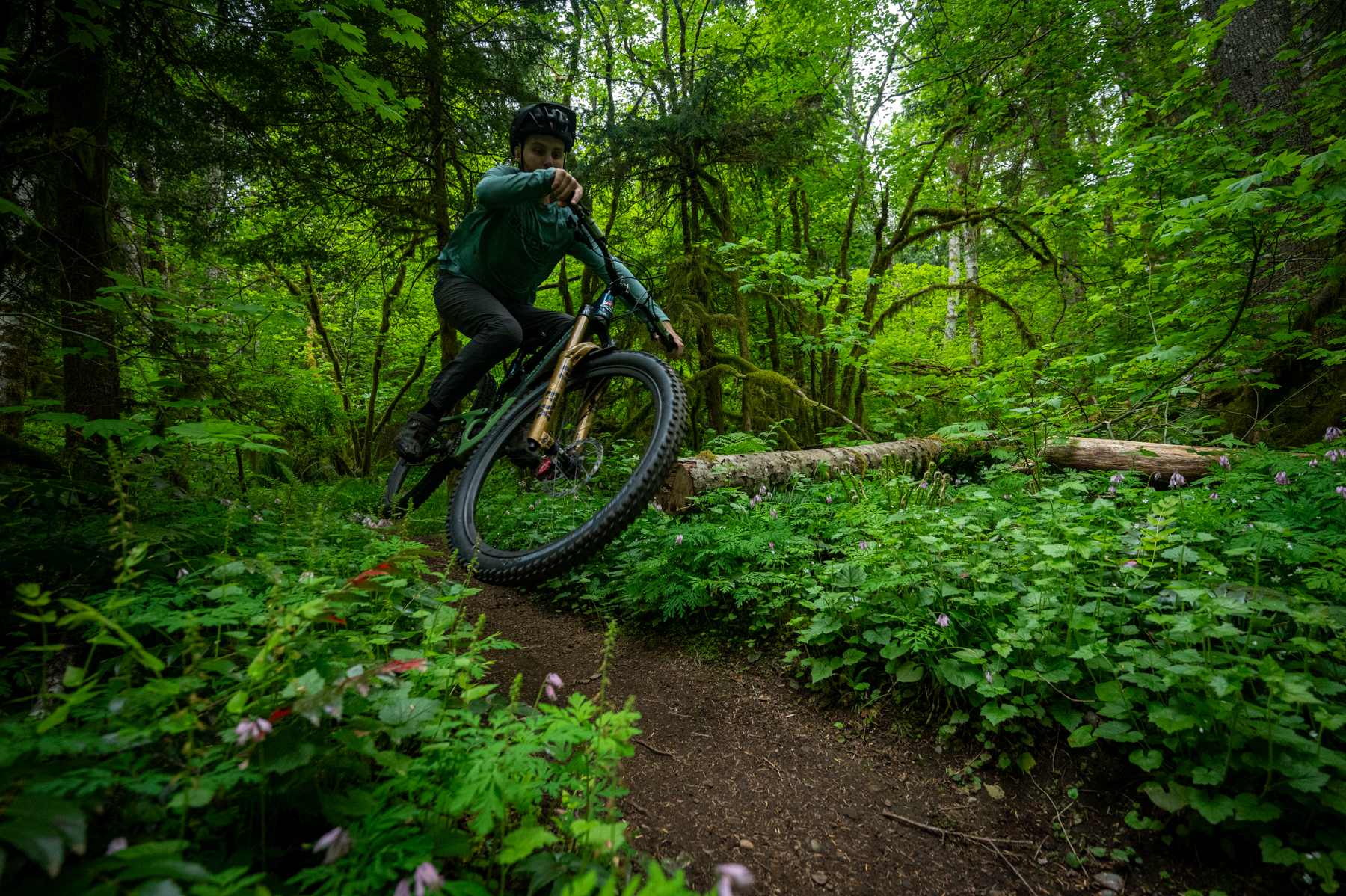
Wild Enduro MS
David: The Wild Enduro MS (for “mixed / soft” conditions) works extremely well as a bridge between true all-rounder tires (e.g., Maxxis Assegai, Maxxis Minion DHF/DHRII, Continental Kryptotals, etc.) and mid-spike tires like the Maxxis Shorty and Continental Argotal.
I suppose that’s pretty much what this tire’s name implies. The Wild Enduro MS works best in dirt that’s soft enough for it to really dig in a bit, but the MS feels a lot less squirmy and unpredictable on harder surfaces than alternatives like the Shorty or Argotal. Those tires clear mud better and have more braking bite when things get really wet and sloppy, but the Wild Enduro MS is a much more versatile option that still fares reasonably well in truly wet conditions, and excels in damp but not fully saturated ones.
The closest comparison I can make is that the Wild Enduro MS reminds me of the Schwalbe Magic Mary, but with much, much more supportive and predictable side knobs. I’ve long thought that the center knob design of the Magic Mary feels very promising in the same sorts of mixed conditions where the Wild Enduro MS excels, but the Mary’s side knobs are too squirmy and cut loose unpredictably in a lot of situations. The Wild Enduro MS fixes that and is basically what I’ve long wanted the Magic Mary to be.
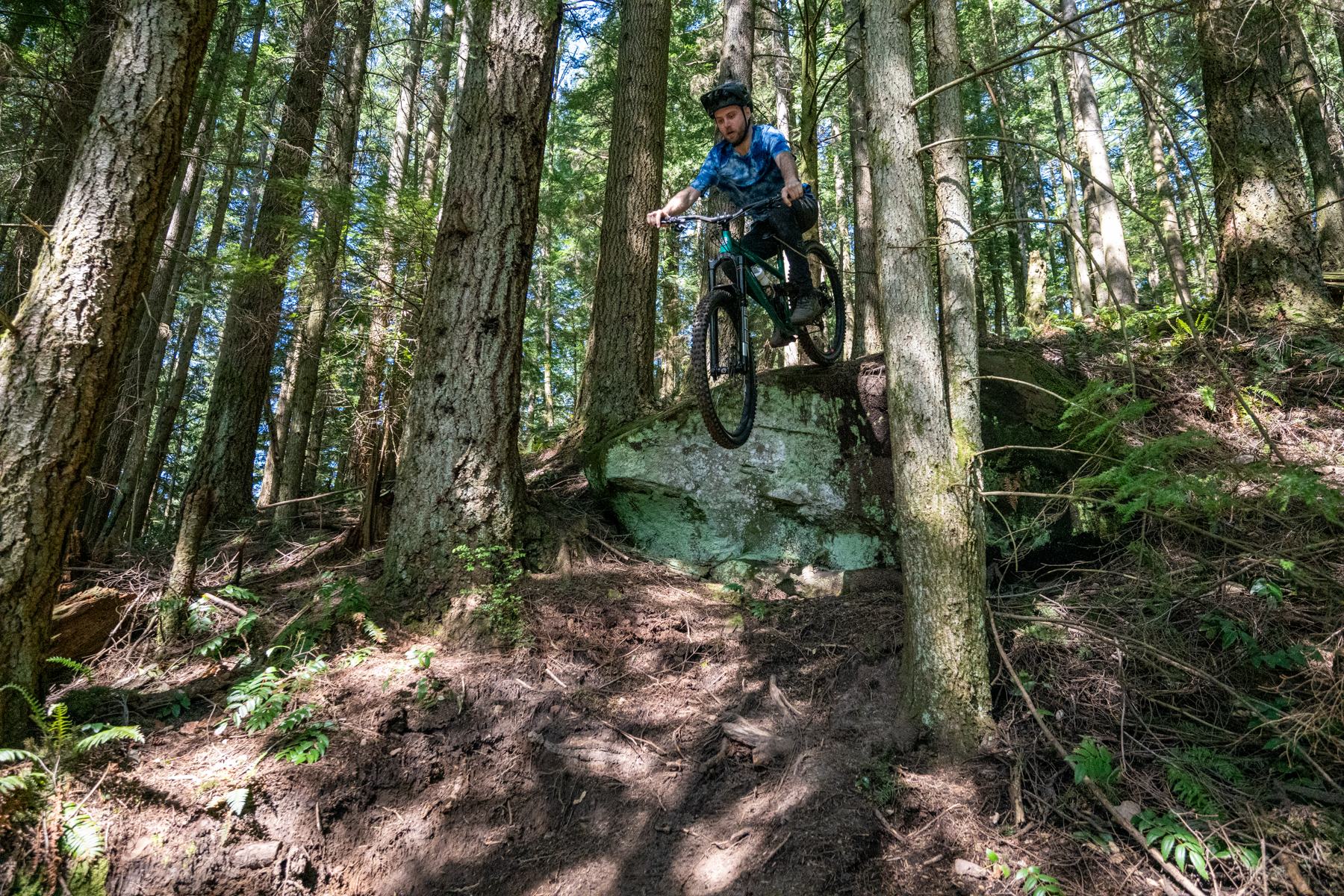
Particularly for where I live in Western Washington, that sort of in-between tire for soft-ish conditions is particularly useful, especially in the spring and fall. It’s pretty common for me to encounter conditions that are soft and loamy, with enough moisture in the soil for more tightly spaced tires (e.g., Maxxis Assegai) to pack up and struggle with braking traction, but where there are still enough firm-ish spots that something like the Shorty takes care to not overwhelm in well-supported corners. The Wild Enduro MS works extremely well in those sorts of conditions.
It’s also a faster (or maybe less slow) rolling tire than I would have guessed based on its tread pattern. It’s not quick, of course — we’re talking about a fairly blocky, open tread pattern with pretty soft rubber, after all — but the Wild Enduro MS is passable in this regard. It’s definitely quicker than, say, a 3C MaxxGrip Maxxis Assegai, and probably a little faster than a Minion DHRII in that same rubber, but it’s appreciably slower than the Continental Kryptotal Front and Rear pair in their DH casing / SuperSoft rubber pairing. Pretty solid, all things considered.
The tradeoff there is that the Wild Enduro MS wears relatively quickly, especially on firmer, rockier surfaces. Michelin’s take is that they focused on making the highest-performing rubber compound that they could — one that’s quite soft and grippy, but that rolls better than a lot of other softer options out there — and that doing so came at a bit of a cost when it comes to durability. That seems fair enough, and the performance really is excellent. As always, there are tradeoffs in product design, and Michelin has simply targeted performance over making a hard-wearing tire.
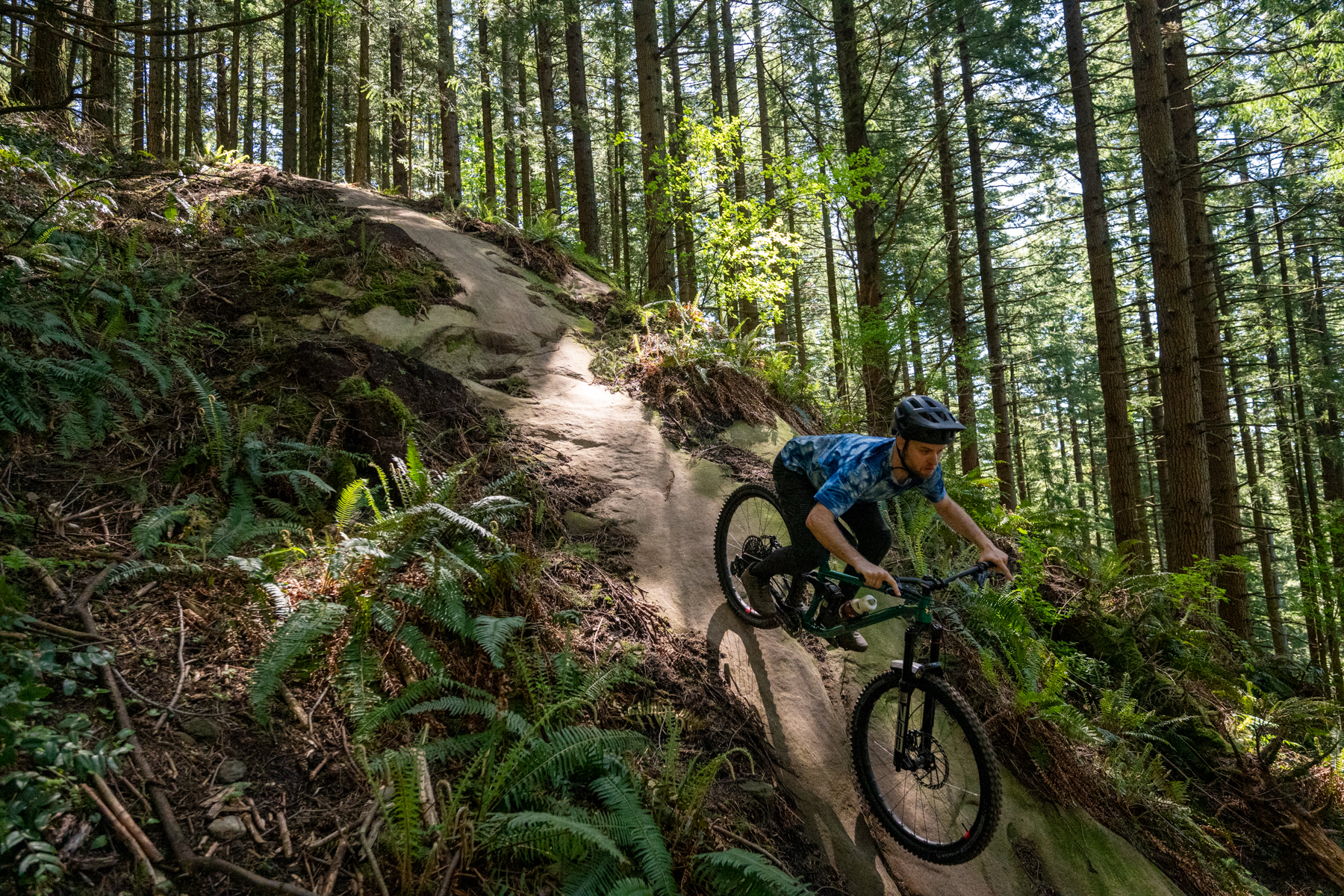
It’s also worth noting that the Wild Enduro MS’ rubber does a pretty good job of not getting hard and wooden-feeling in colder temperatures. Like most tires, it still firms up appreciably when temperatures get within spitting distance of freezing, but the effect is less pronounced than many other tires, and the MS still feels really good down to the mid-to-high 40s F (~8° C).
Zack Henderson (6′, 165 lb / 183 cm, 74.9 kg): I completely agree with David’s assessment of the Wild Enduro MS as being best in soft conditions, but that it’s fast rolling and supportive enough to be used in firmer ones. Tires like that are a bit hard to come by, but they tend to be what I look for as my anytime-but-peak-summer tire for Western Washington trails.
The tall-ish knobs of the Wild Enduro MS do a good job of clawing for traction without feeling overly draggy on climbs, nor do they fold over in firmer conditions like a Maxxis Shorty. The Wild Enduro MS’s fairly tall side knobs initially had me a bit concerned that they might fold over on faster and firmer trails, but they’ve proven more supportive than I expected. They still aren’t in the same bracket as a Maxxis Assegai in that regard, but they also feel way more predictable than the similarly-intentioned Schwalbe Magic Mary. Of course, the Assegai rolls quite a bit slower in the MaxxGrip compound and clogs up much more quickly in thicker mud, and I generally see it as a bit more of a dry-conditions tire.
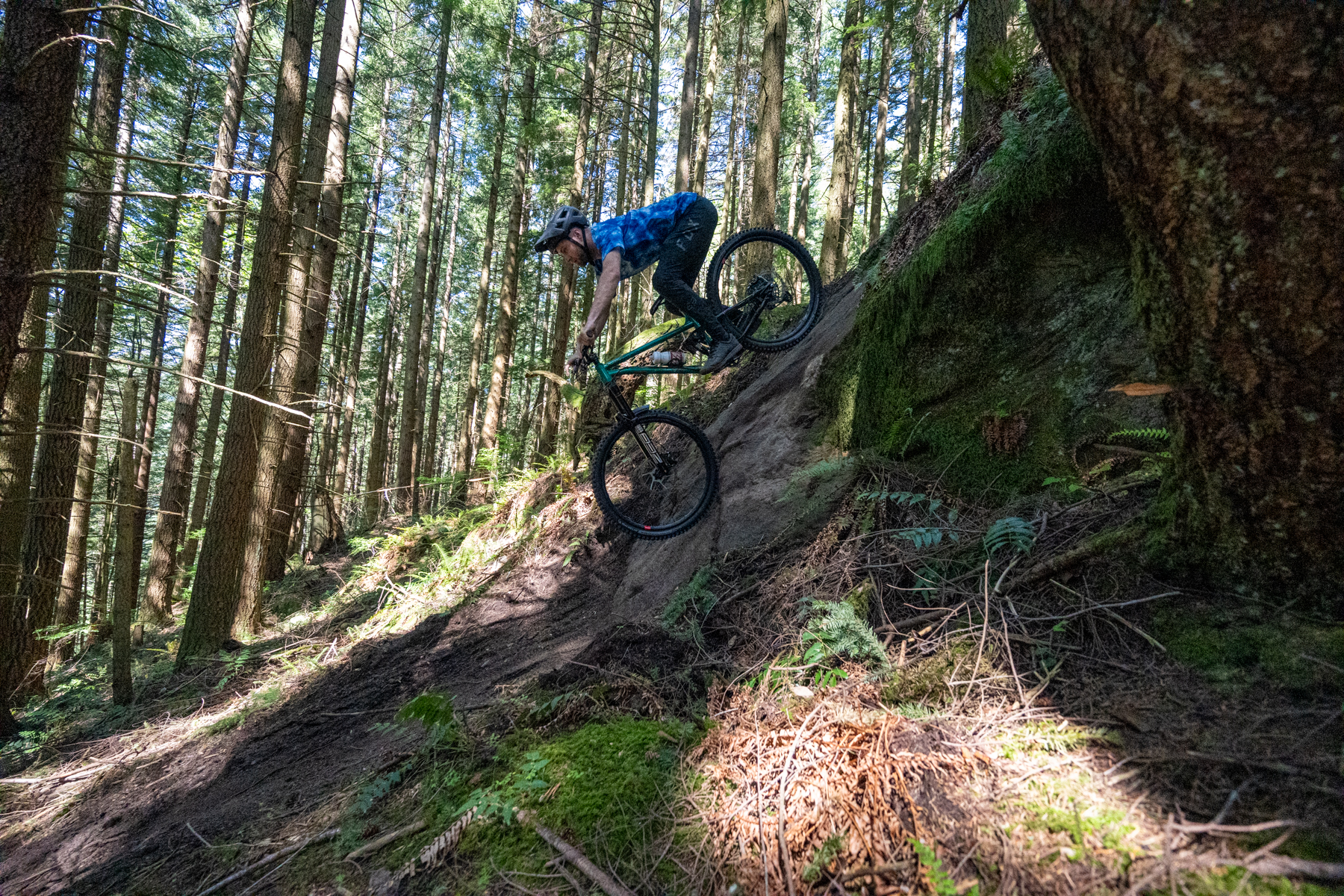
My quest for a versatile shoulder-season tire like the Wild Enduro MS has also led me to my prior Fall favorite, the updated Specialized Hillbilly. The Hillbilly is much more of a cut spike tread, but its knobs have better support than the comparable Maxxis Shorty, with the Hillbilly’s side knobs feeling notably supportive for such a soft-conditions-oriented tire. That said, the Hillbilly doesn’t offer the same balance of poise and solid rolling speed that the Wild Enduro MS has shown on firmer trails, and the Wild Enduro MS is more predictable on wet rock slabs and roots. The Wild Enduro MS’s casing feels a bit more compliant, too, relative to the more wooden-feeling Grid Gravity casing on the Hillbilly.
I haven’t spent as much time on the Wild Enduro MS as David has, but I have already noticed a bit of tread wear. So far, they seem to be wearing quite evenly, but I don’t foresee these being a particularly long-lived tire. As David mentioned, the wear seems to be faster in drier and firmer conditions, but the casing isn’t showing any signs of stress, like threads starting to show through, etc.
Wild Enduro Rear
David: Semi-slick tires aren’t terribly commonplace anymore, but that’s essentially what the Wild Enduro Rear is — and in the right conditions, it’s a pretty good one. A lot of semi-slick tires over the years (e.g., the Maxxis Minion SS) have felt like they were more or less a different, more aggressive tire with the center knobs lopped off. While that’s fine in theory, in practice, it tends to make the side knobs too prominent and the overall tire profile too square. That both hurts rolling resistance — the main point of a semi-slick tire in the first place — and tends to make the front and rear tires grip best at very different lean angles, which can be tough to manage.
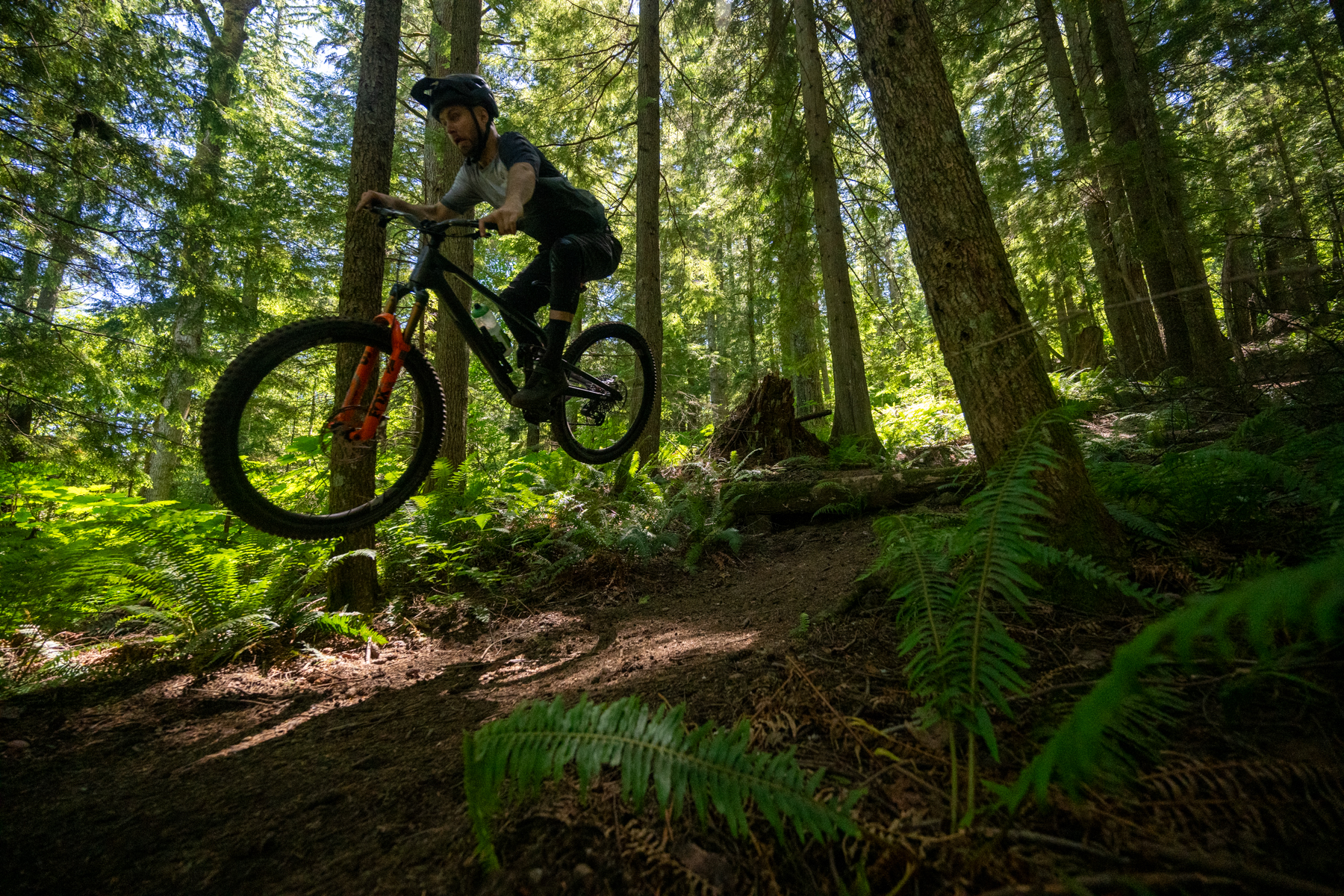
Michelin hasn’t fallen into that trap. The Wild Enduro Rear gets a low, tightly spaced center tread with much burlier side knobs, but they’re positioned low enough on the tire, and the casing is round enough, for the overall profile to come together nicely. The transition from the center knobs to the side ones is smooth and predictable
Unsurprisingly, the Wild Enduro Rear rolls quite well, particularly on firmer surfaces, but doesn’t offer much for braking traction, especially if things are soft or loose. There’s decent cornering grip once you get the tire up on edge, but it’s a fairly loose, drift-y feeling tire overall — particularly if there’s a bit of loose dirt over a harder base.
I think a lot of that driftiness is just down to the tire’s below-average braking grip, which, again, is most noticeable in loose-over-hard scenarios. It just doesn’t take much heavy braking to overwhelm the Wild Enduro Rear and get it to step out. It does so in a nice, predictable, and controllable manner — we’re talking about a smooth entry into a drift rather than the tire just fully giving up for the most part.
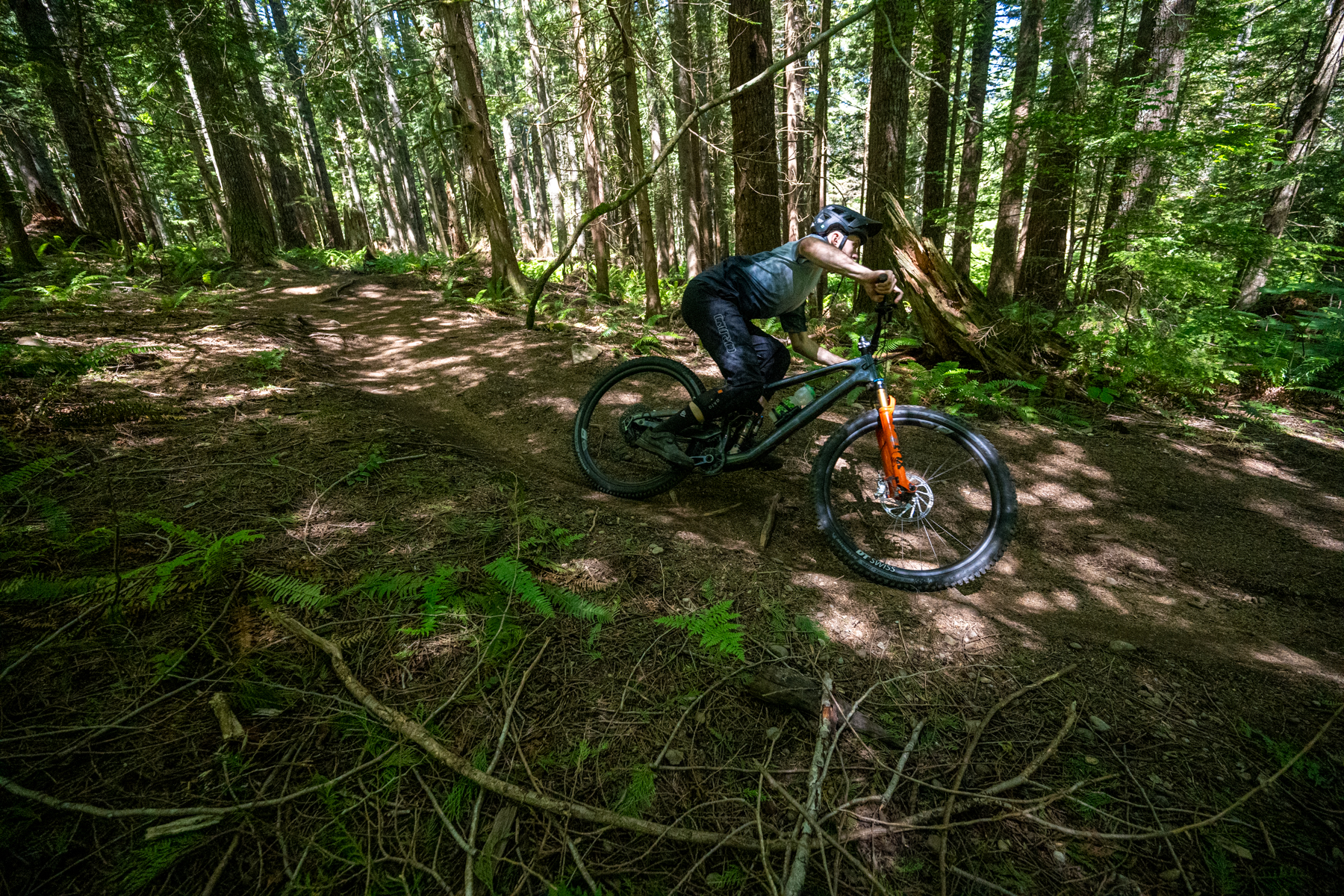
Big picture, the Wild Enduro Rear is a promising option for folks who ride a lot of firm, hardpacked trails that don’t tend to get super loose and dusty — especially if those trails are also not wildly steep. Rolling resistance doesn’t matter if you’re on the brakes anyway, and the Wild Enduro Rear’s ability to really drop anchor is limited. As someone who lives in Western Washington, it’s frankly not the most practical choice around here most of the time, since our trails are often very steep, and true hardpack is relatively rare. But, of course, that’s not true in a lot of other places, and the combination of a fast-rolling tread pattern with solid side knobs and a stout casing is a compelling one in the right conditions.
DH 16
David: The DH 16 is Michelin’s drier / firmer-condition-oriented DH tire, and it’s one of the best tires I’ve tried to date for loose-over-hard conditions in particular. It rolls relatively well for an aggressive, gravity-oriented tire — credit, I think, the big ramps on the leading edge of the center knobs. Its side knobs are also well-supported and predictable in how they communicate where the limit is and in how they eventually break loose when you push past it. But it’s the DH 16’s braking performance that I’m most impressed with.
A lot of tires — even ones that brake relatively well in general — struggle with braking bite and consistency in loose-over-hard conditions, and the DH 16 stands out for how well it does there. Its braking grip is quite good, but especially in loose, dusty conditions where there’s a real limit to how much braking power the dirt can support, the DH 16 also does a way above average job of tracking straight and not stepping out if you momentarily overwhelm it and lock up a wheel.
The DH 16 takes some commitment to engage the side knobs as you start to lean it into a corner, but there’s a lot of grip in a fairly wide range of conditions if you take the right approach. There’s a distinct open zone between the DH 16’s center and side knobs that you need to lean through, but the DH 16 hooks up consistently and predictably once you do. Having that sort of open zone tends to help make room for the side knobs to really engage once you get the tire leaned over, and I think that’s true here. The DH 16 feels more solid and more communicative of how the side knobs are engaging than most tires with pronounced transition knobs (e.g., Maxxis Assegai), especially on firmer surfaces.
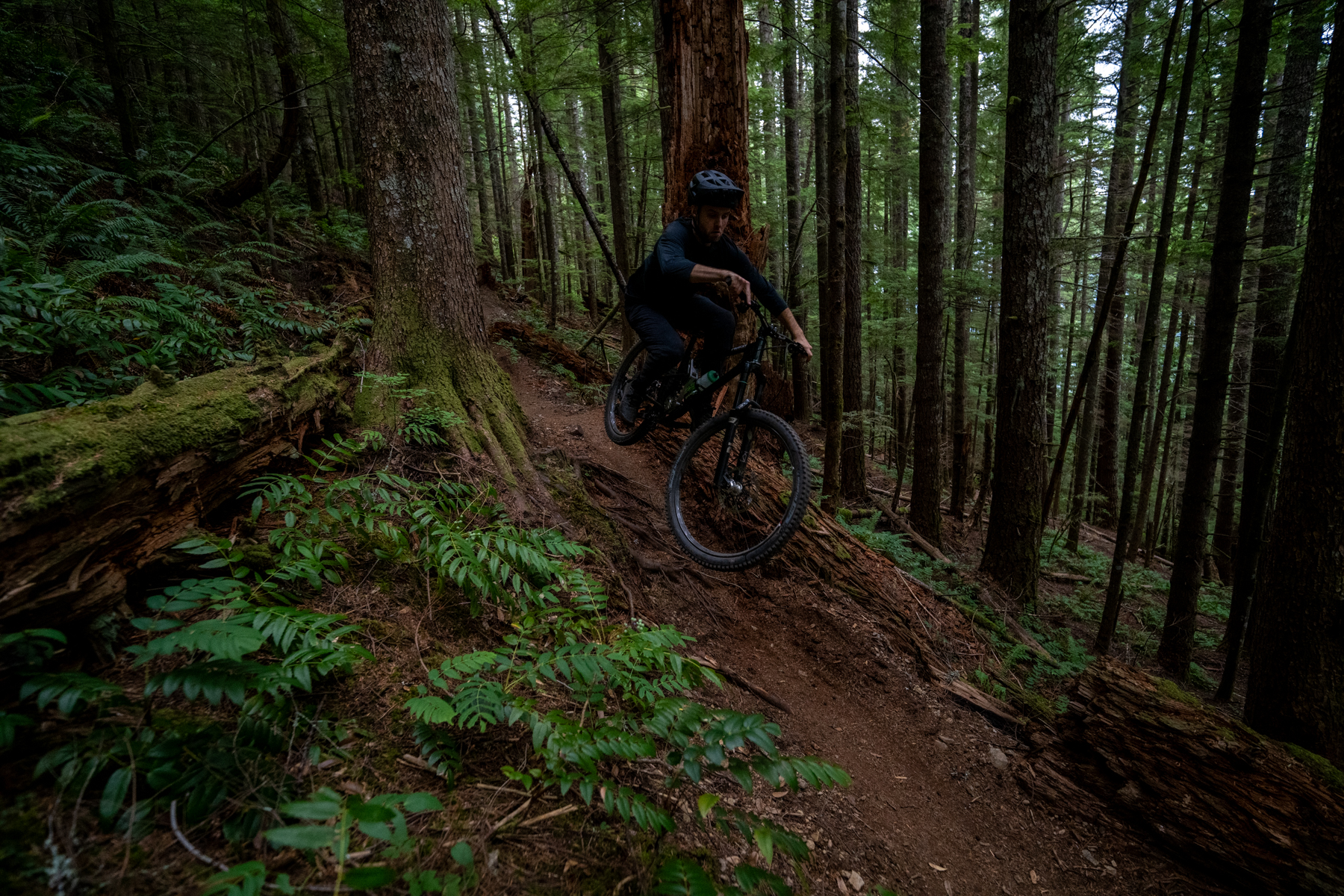
When things start getting damp, the DH 16’s performance falls off appreciably, particularly in stickier, higher-clay-content soil. It’s not like it’s allergic to the slightest bit of moisture by any stretch, and I’m still pretty happy running the DH 16 as a rear tire in fairly wet conditions, but it doesn’t take all that much moisture in the ground for there to start to be better options.
I think the DH 16’s wide center knobs (which serve it so well under braking in looser, drier conditions) start to struggle to really penetrate more damp dirt, and they’re fairly quick to pack up if the soil is muddy and sticky. The DH 16 also isn’t the most confidence-inspiring on wet roots, which I think comes down to its wide center knobs not leaving many edges to hunt for whatever grip they can find there. But that’s definitely pushing the DH 16 outside of the conditions it’s really meant for, and as an aggressive tire for dry and loose conditions, it’s something special.
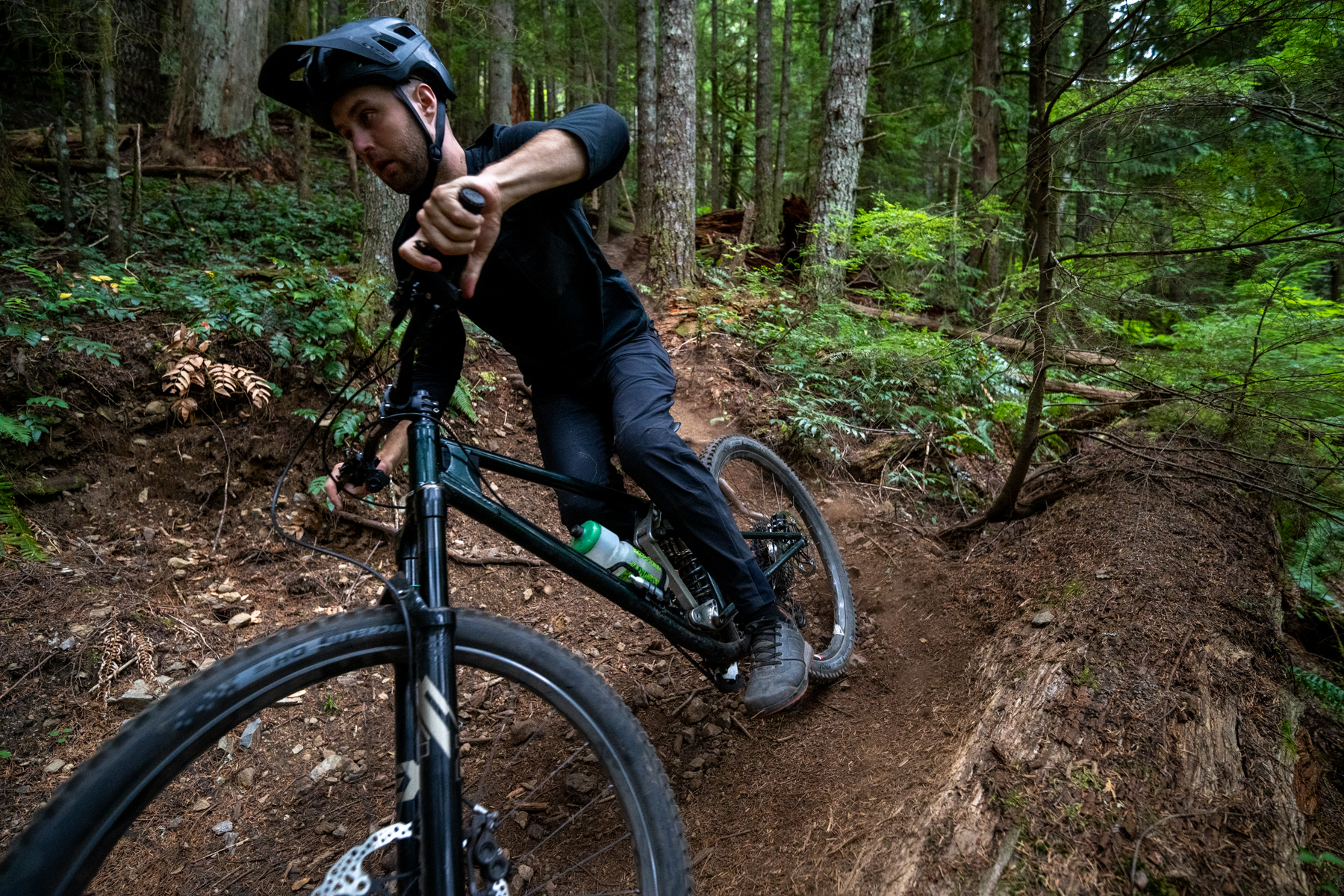
DH 22
David: The DH 22’s tread design is almost identical to that of the Wild Enduro MS, and the two share the same rubber formulation — the casing is the biggest point of differentiation between the two. The DH22’s knobs feature a very slight chamfer on the leading edge, presumably to help reduce rolling resistance, but that’s the only difference I can see or measure.
As with the DH 16, the DH 22 gets Michelin’s updated DH casing; it now features a folding bead and feels a bit less stiff and wooden than Michelin’s DH tires of old. It’s still a burly, relatively stiff casing — more so than Maxxis or Continental’s DH casings — but it’s much less of an outlier than the prior version.
The DH 22’s sidewalls are noticeably stiffer and more supportive (but correspondingly less supple) than those of the Wild Enduro MS, but their performance is otherwise pretty much identical. It’s analogous to comparing two otherwise identical Maxxis tires in their DoubleDown and DH casings, for example.
The Wild Enduro MS rides a little more smoothly at more moderate speeds. The DH 22 feels better supported when you’re going faster and hitting things harder, but they’re slightly different flavors of the same overall design, rather than being all that different from each other. If the DH 22 rolls any faster due to its subtly chamfered knobs, I’d be hard-pressed to tell — or maybe the advantage is just canceled out by the beefier casing and added weight.
Regardless of which exact construction you’d prefer, the Wild Enduro MS / DH 22 are very high on my list of recommendations if you’re after a tire for generally wet / soft-ish conditions, but you want something that’s more versatile across a wider range of ones than more dedicated mid-spike tires. Both of them have homes on my personal bikes for the PNW winter.
Bottom Line
In sum, Michelin has done a commendable job of updating their Gravity tire lineup. The new DH tires are way lighter than the outgoing versions, the new casing feels significantly more supple, and the new Wild Enduro variants offer something for most conditions you’d find on an Enduro bike. Each model has its pros and cons, but several of them are staying around as reference tires going forward.

Interesting, isnt 2×55 typically considered more burly than swapping one of them out for a 120tpi layer.
Really looking forward to a full review. – soon perhaps. Its been a while since May ‘;~}
Your unbiased reviews are very much appreciated. You’ve led me to a lot of successful purchases.
I’ve been holding off until I can get them into a wider range of conditions than just dry mid summer ones, but with the wetter season starting up it won’t be too much longer.
I’m particularly interested in the new DH16 magi-x 27.5 for the rear of a Kenevo SL for the wet season. I love the (older v1) DH22 upfront.
I Love that even SL style e-bikes with minimal support allow pedalling proper rubber around the trails.
Thanks for all you do.
Thanks for this guys! Michelin certainly has the manpower and technology to put out great tires, but their line up was a bit confusing, they were often extremely heavy, and there were not many reviews out for them, so it’s good they redid them and you are giving them a full review.
The Wild Enduro MS looks like an appealing option for my enduro bike for the wet half of my season in in Portland, OR. You say it sits between the Assegai and the Shorty, but I’d really like to know how it compares to the new High Roller III, which I’ve been running in the front for the last three weeks and I’m loving it.
I’m pretty close to wrapping up our HRIII review, and I’ll include that comparison in that one.
Great review guys.
Thanks.
I guess it’s now been updated and is containing all your thoughts or are there more updates coming?
I did get the Mich DH16 for the rear (DH22 front) for Autumnal trail riding on a Kenevo SL.
Question-
As you both found the Enduro rear to be compromised I wonder if you tested the MS on the back?
My one possible down on the DH 16&22 combo (although they work real well) is that those DH casings must be tougher to deform over roots (which of course are now wet) costing grip even at say 20psi.
The Enduro MS (27.5, on the back) might be nice in that wet but not clay arena. (Because if the more supple casing)
Of course I await your HighRoller thoughts with enthusiasm
Hmm.
“Radial” trail casing extra soft Schwalbe Albert rear (for non clay wet trail use) . Maybe ‘;~}.
Always liked the Blister tyre reviews
Unbiased
Honest
Kevins review gave me one of my long time favourites, the Bontrager G5.
Hey Neil,
We’re wrapped up with this one, but will keep bringing up comparisons to the Michelin lineup where appropriate in future reviews, including the High Roller one which is coming soon.
And yep, I’ve run the MS front and rear extensively. It works great.
Thanks David. Tracked down your review and joined up as a digital member to see the flash review. Looks like the MS might find a place on the rear with DH22 front (as I have it).
Hey,
I’m in the process of buying new tires for my enduro bike. I’m considering a DH16 rear and Enduro MS front combo. I do a fair bit of climbing in my rides bet equal measure descent in both natural and bike park. I’m considering the DH rear as I dont typically run liners. Thoughts on that as a combo?
James. The DH16 is a great rear tyre (on my Enduro bike an Kenevo SL) and has amazing braking and turning grip. It’s impressive even on fairly soft (but not clay) ground. I did notice that, if it’s wet, that technical climbing is compromised by the tapered edge blocks (those that make it roll easier, it’s a trade off). It’s a pretty rigid casing too, as you’d expect. Thankfully I have the SL motor to help with pedalling.
I took off a Schwalbe Betty and the 16 doesn’t seem harder to pedal.
On David’s advice I’m about to test the Enduro tyre in MS form on the rear. (There’s a separate review on the Enduro options) It’s a pretty sturdy casing so I’m not fretting about flats, but hoping it’s a touch more flexible for better action on the seasons wet roots.
If I like the MS rear I may well put one upfront. Maybe the MH would suit you as a rear. David’s flash review mentions that he used both MS and MH as rears and liked them.
Hello, could you tell me what air pressure you used on the Wild Enduro MS at what rider weight? I find this tire feels relatively hard at 20 psi and above. Not bad, but still a bit hard.
Thanks.
Thanks for the reply. That is my thought process or decision im trying to make as well… DH 16 or MH as rear. I was thinking DH16 as I don’t run a liner but now I think im leaning back to the MH. Thanks again.
How did you get on James. Despite the slight jacking climbing grip compared I’m still favouring the DH16 as a rear over the Enduro MS.
I can’t tell whether this review is if the “Racing Line” Michelin Enduros. Maybe those have a different casing.
Too many tyres.
There aren’t non-Racing Line versions of either the DH22 or DH16. We left that off for brevity and because Michelin doesn’t always mention “racing line” in the name / there isn’t any need to differentiate it from another version. They could be more clear in their descriptions, for sure, but there’s just the single version of the DH22 and DH16.
Hello, could you tell me what air pressure you used on the Wild Enduro MS at what rider weight? I find this tire feels relatively hard at 20 psi and above. Not bad, but still a bit hard. Thanks.
Hi all. Anyone got any feedback on the performance difference between the dh 16 and big betty for the rear? Mostly dry over hard with lots of loose sharp rock. Running a high roller 3 up front and big betty rear, don’t care about differing brands just want the grip. Cheers